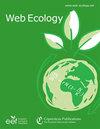Ecological correlates of crop yield growth and interannual yield variation at a global scale
IF 2.4
3区 环境科学与生态学
Q2 ECOLOGY
引用次数: 4
Abstract
Abstract. Artificial selection and genetic engineering plus an expanding repertoire and use of agrochemical inputs have allowed a rapid and continuous increase in crop yield (i.e., volume production per unit area) over the last century, which is needed to fulfill food demands from a growing human population. However, the first signs of yield deceleration and stagnation have already been reported for some globally important crops. Therefore, the study of the drivers of yield growth and its variation is essential for directing research and policies aiming at ensuring food security in the forthcoming years. We used data on mean and variability in annual yield growth for 107 globally important crops to assess the role of environmental (i.e., climatic region) and plant intrinsic traits (i.e., type of harvested organ, pollinator dependence, and life form) as drivers of change in yield growth and its stability. We applied a comparative approach to control for biases associated with phylogenetic non-independence among crops, an approach rarely used in agronomic studies. Average yield growth and its variation were not phylogenetically structured. Yield growth decreased with increasing pollinator dependence in tree crops but not in herbaceous and shrubby crops. Interannual yield variation tended to increase with increasing pollinator dependence, and it was higher in crops from temperate regions, in those cultivated for their reproductive organs, and in tree and shrubby crops as compared with herbaceous ones. Information on ecological correlates of crop yield growth and interannual yield variation can be used in the design of more sustainable and diversified agriculture schemes.全球尺度下作物产量生长与年际变化的生态关联
摘要在上个世纪,人工选择和基因工程加上农用化学品投入物的不断扩大和使用,使作物产量(即单位面积产量)得以快速和持续地提高,这是满足不断增长的人口对粮食需求所必需的。然而,一些全球重要作物已经出现了产量减速和停滞的初步迹象。因此,研究产量增长的驱动因素及其变化对于指导旨在确保未来几年粮食安全的研究和政策至关重要。我们使用107种全球重要作物的年平均产量增长和变率数据来评估环境(即气候区域)和植物内在性状(即收获器官类型、传粉者依赖性和生命形式)作为产量增长及其稳定性变化驱动因素的作用。我们采用比较方法来控制与作物系统发育不独立性相关的偏倚,这是一种在农艺研究中很少使用的方法。平均产量增长及其变异没有系统发育结构。随着对传粉者依赖性的增加,乔木作物的产量增长下降,而草本和灌木作物则没有。年际产量变化随传粉者依赖性的增加而增加,温带作物、生殖器官栽培作物、乔木和灌木作物的年际产量变化高于草本作物。有关作物生长和年际产量变化的生态相关信息可用于设计更可持续和多样化的农业方案。
本文章由计算机程序翻译,如有差异,请以英文原文为准。
求助全文
约1分钟内获得全文
求助全文
来源期刊

Web Ecology
Agricultural and Biological Sciences-Ecology, Evolution, Behavior and Systematics
CiteScore
4.60
自引率
0.00%
发文量
6
审稿时长
17 weeks
期刊介绍:
Web Ecology (WE) is an open-access journal issued by the European Ecological Federation (EEF) representing the ecological societies within Europe and associated members. Its special value is to serve as a publication forum for national ecological societies that do not maintain their own society journal. Web Ecology publishes papers from all fields of ecology without any geographic restriction. It is a forum to communicate results of experimental, theoretical, and descriptive studies of general interest to an international audience. Original contributions, short communications, and reviews on ecological research on all kinds of organisms and ecosystems are welcome as well as papers that express emerging ideas and concepts with a sound scientific background.
 求助内容:
求助内容: 应助结果提醒方式:
应助结果提醒方式:


